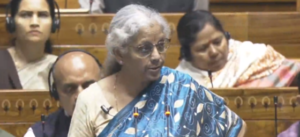Budgets over the years have become a tiresome spectacle. Much print space and airtime are devoted to the exercise, which on each occasion is presented as an event that would alter the nation’s economic course. Governments and Finance Ministers back that narrative, not least by shrouding the exercise in secrecy till the budget speech is read. But in recent years, with the government adopting measures that erode its own revenues, and having, with the passing of the Fiscal Responsibility and Budget Management Act in 2003, limited its right to borrow, there is not much the budget as an instrument of mobilizing and allocating resources can do. The budget speech has been reduced to a long and diversionary litany of off-budget measures and “reforms”, most of which are forgotten and recalled, if at all, only in the next budget speech.
This was not the way budgets used to be. Backed by five-year and longer-term ‘perspective’ plans, the budgets were seen as indicators of the government’s commitment to implement those plans and of how the costs and benefits associated with those plans were to be distributed across sections of the populations. The planning process was over time diluted and finally, under Prime Minister Modi, scrapped. The government’s ability to mobilize resources was eroded by neoliberal fiscal reform, which also sought to cap, even if only with partial success, government borrowing. The ‘budget’ became an annual record of how much further the government goes down this path, how it manages to finance unavoidable expenditures by, say, selling public assets, and what this could mean for economic performance. The ‘budget speech’, on the other hand, became a leaflet declaring how the government plans to get other agents, like the banks, public corporations and the private sector, to make up for its own growing inaction.
Given this background, few would take seriously Finance Minister Nirmala Sitharam’s claim that Budget 2021-22 would be one “like never before”. But it is not just the government’s long-term fiscal stance that warrants such scepticism. It is the government’s actions over financial year 2020-21, which, because of Covid-19, was almost a year “like never before”. It is now well established that the pandemic and the sudden and extremely severe lockdown announced by the government around a week before the financial year began on April 1 had a devastating effect on livelihoods and economic activity. Almost all sections of society looked to the government for a response that mitigated and resolved the crisis. Their demand, as was the case in countries across the globe, was that the government must spend … spend … and spend, not just to address the health emergency, but to throw out a social safety net to protect all those the pandemic had ravaged and to reverse the downturn and kick-start a recovery.
This was a difficult call for the Finance Minister to take. In pursuit of the NDAs neoliberal strategy, she had in September 2019 sacrificed a chunk of tax revenues as a response to the pre-pandemic recession. She announced a ‘stimulus’ in the form of a huge reduction in the corporate tax rate from 30 per cent (or an effective rate of 34.61 per cent after surcharge and cess) to 22 per cent (or an effective rate of 25.17 per cent) for domestic companies that do not avail of tax incentives or exemptions. New domestic manufacturing companies incorporated on or after October 1, 2019 were to pay corporation tax at the reduced rate of 15 per cent (which is an effective rate of 17.01 per cent) so long as they do not avail of incentives and exemptions. And the minimum alternative tax (MAT) applicable to companies that do avail of incentives and exemptions was reduced from 18.5 per cent to 15 per cent. The measure fattened profits but did little to revive investment, which was demand constrained. It was also estimated to result in revenue foregone of anywhere up Rs. 1.45 lakh crore in a full year or around 0.8 per cent of GDP.
Loss of revenues on account of such measures was compounded by the effects of the pandemic-induced 23 per cent contraction in GDP in the first quarter of financial year 2020-21, which was followed by a further 7.5 per cent contraction in the second quarter. The result has been a 8.3 per cent fall in the Centre’s net tax revenue over April to November 2020, the first eight months of this financial year, relative to April to November 2019. Combine this with the fact that receipts from disinvestment of government’s equity holdings in public sector enterprises and public sector banks and financial institutions which, controversially, were budgeted at an astronomical Rs. 2,10,000 crore for 2020-21 had yielded only Rs. 6,178.79 crore over the first 8 months of the financial year, and it becomes clear that enhanced spending had to be financed with borrowing.
Given the exceptional circumstances, there was widespread acceptance that, even if for a year or two, the government should deviate significantly from its fiscal deficit target set through the FRBM Act and widen deficit spending. Once the pandemic is behind us and the recovery starts, it was argued, a fresh effort at mobilizing resources and managing expenditures to rein in that deficit and bring down the stock of debt can begin. That was the consensus globally as well, with many advocates of fiscal conservatism arguing for a spell of Keynesian-style demand management.
The NDA government too declared that it would launch a stimulus that in multiple steps will do what needs to be done. What does the available evidence indicate? The fiscal deficit of the Centre over April-November has indeed risen by 33 per cent, from Rs. 8,07,834 crore in 2019-20 to Rs. 10,75,507 crore in 2020-21. But given the need to cover the loss of revenue resulting from the September 2019 corporate tax bonanza and the pandemic-induced collapse in economic activity, this was hardly enough. Moreover, as noted, privatization receipts which are not included in the fiscal deficit have fallen way short of target, necessitating some compensatory increase in deficit spending. In the event, the absence of a sharp shift in the fiscal stance has resulted in the fact that total expenditure over the first 8 months of 2020-21 has risen by just 4.7 per cent in nominal terms relative to the corresponding months of 2019-20. Allowing for inflation, real expenditure has in fact fallen. Not really the right medicine in a year “like never before”.
Given the obsession with not pushing the envelope with respect to deficit spending, even this meagre spending effort was ensured by opting for measures that must have hurt those who needed to be helped. A remarkable feature of the fall in revenue receipts during April to November 2020 relative to April to November 2019 is the composition of that decline. Corporation tax declined by as much as 35.7 per cent across these two periods, because of the combined effects of the tax bonanza and the recession. Income tax receipts fell by 12.3 percent. Receipts from the central goods and services tax fell by 25.3 per cent, signalling the much-discussed poor performance on the GST front before and during the pandemic. The only exception to these trends was receipts from union excise duties, which rose by 47.7 per cent from Rs. 1,32,899 crore during April to November 2019 to Rs. 1,96,342 crore during April to November 2020.
As has been widely reported, there is one explanation for this, which is the NDA government’s reliance on massive hikes in duties on petroleum products. In two steps in March and May 2020, while the pandemic ravaged the economy, the government at the Centre increased the excise duty on petrol and diesel by Rs. 13 and Rs. 16 per litre respectively, taking the total excise duty imposed on petrol to Rs 32.98 per litre and that on diesel to Rs 31.83 a litre. The burden that implies should be clear from the fact that the price of petrol and diesel in the capital city is Rs. 84.7 and Rs. 74.88 respectively. These decisions too reflect the persistence with its past policy predilections during the pandemic. Despite volatility in oil prices, the tendency has been to impose high excise levies on petroleum products, on the grounds that they are warranted because international prices have come down. Even ignoring the unexplained premise that it is the government, and not the consumer, that should derive the benefit of any fall in oil prices, the claim of the government is without any basis. Early in its term, the first Modi government had in nine steps between November 2014 and January 2016 raised the excise duty, from the levels it inherited of Rs. 9.48 and Rs. 3.56 per litre on petrol and diesel, by Rs 11.77 and 13.47 a litre. Only a fraction of that hike was rolled back when oil prices began to rise. Then, the government again raised duties in July 2019, March 2020 and May 2020, to the extent of Rs 15-18 a litre. These increases did not help increase expenditures during the pandemic, but only neutralized a part of the revenue loss so as to rein in the fiscal deficit.
Thus the Centre’s levies have risen even when the plea of low oil prices used to justify high levies had lost its strength. The result has been a rise in the retail prices of petroleum products. Higher oil prices raise transportation costs and, since oil is a universal intermediate, push up costs and prices of all commodities, including the necessities that those hurt by the pandemic are hard pressed to buy. This squeezes the purchasing power of these sections even further, and by curtailing mass demand worsens the recession. If instead, the deficit is kept down through taxation of higher income groups, demand would not be adversely affected.
To sum up, financial year 2020-21 was one “like never before”. It warranted a change in the stance of the government, with a shift away from fiscal conservatism to a more proactive fiscal policy. There was widespread agreement that this was the way to go, even among those who in “normal times” advocated a conservative fiscal stance. But the NDA government has persisted with its neoliberal fiscal stance, resulting in collapsing revenues and stagnant expenditures. Given that evidence, few would buy the idea that the finance minister of that government would present a budget “like never before”.
(C.P. Chandrasekhar is Professor at the Centre for Economic Studies and Planning, Jawaharlal Nehru University, New Delhi.)




